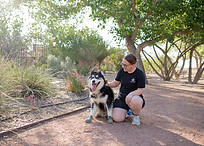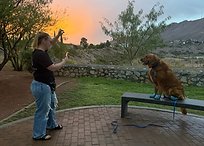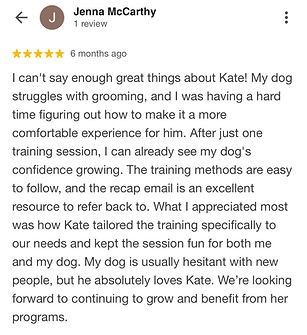
ABOUT ME

At Kates Kanines, we don’t just train dogs
— we empower them. "Kate"
My method focuses on positive reinforcement that encourages autonomy, because dogs learn best when they feel safe, confident, and in control of their choices. This approach taps into your dog’s natural ability to learn and adapt also known as neuroplasticity helping behaviors stick for the long term.
Curious how this method came to be? Here's the why behind everything I do.
I didn’t always train this way. I started in what’s known as the “balanced” world of dog training using a mix of tools and techniques. I worked under many different trainers on purpose. I didn’t want to follow just one path. I wanted to learn them all, see what worked, what didn’t, and most importantly, what truly made a difference for the dog in front of me.
Then, life gave me another teacher: my son. At just four years old, he was diagnosed with ADHD, and they were considering adding ODD (Oppositional Defiant Disorder). We tried everything: medications, specialists, behavior charts. But the meds made him feel sick... worse, they made him feel like he had no control over his own body.
I couldn’t accept that. So, I went all in.
We started at home removing food dyes, cooking from scratch and slowly, his behavior started to shift. We found more clarity, fewer meltdowns, and more moments of connection. That was my first real lesson in how environment, nourishment, and autonomy impact behavior.
And while it might sound unrelated to dog training, it has everything to do with it.
That experience opened the door to something I’d never considered before: neuroplasticity, the brain’s ability to change and rewire itself. I was hooked. I read, studied, took courses, watched seminars, and immersed myself in the science of learning and I brought that knowledge right back into my training.
What I discovered was this: when dogs are given the chance to learn through choice and trust rather than compliance or pressure their behavior shifts more smoothly, more sustainably, and with far less resistance. It works, not just in theory, but in real-life homes with real-life dogs and the real-life chaos that comes with them.
Is it how everyone trains? No, but I’ve never wanted to do things the way they’ve always been done. “What works” is only the beginning. There’s always more to learn and I’ll never stop digging deeper to give your dog (and you) the best chance at lasting success.

Reviews from google



Training is a lifestyle.
Lasting results don’t come from a single session, they come from what you do in between and after your classes have ended.
My job is to set you and your dog up for success by teaching you everything you need to know: the tools, the techniques, and the why behind them. You'll walk away with a clear plan and the confidence to follow through.
But progress depends on your consistency. Your dog learns through repetition, routine, and clarity and you’re the one guiding that learning every day.
The good news? You won’t be left guessing. When you stay consistent and apply what you’ve learned, real change will happen and you’ll see just how capable you and your dog truly are.
Training isn’t about doing more, it’s about doing things differently. With the right knowledge and follow-through, you’ve got everything it takes.




